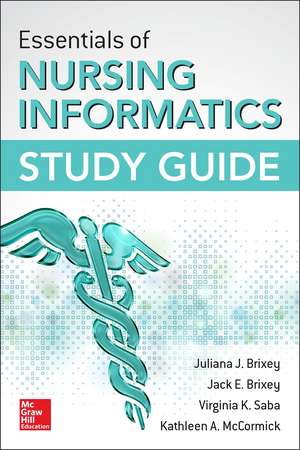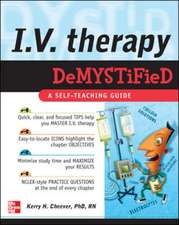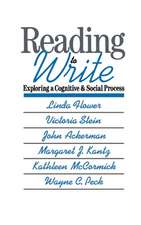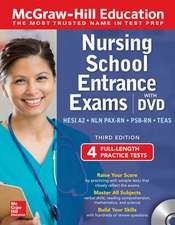Essentials of Nursing Informatics Study Guide
Autor Juliana Brixey, Jack Brixey, Virginia Saba, Kathleen McCormicken Limba Engleză Paperback – 16 noi 2015
Introducing the most complete, compact guide to teaching and learning nursing informatics
If you’re looking for a clear, streamlined review of nursing informatics fundamentals, Essentials of Nursing Informatics Study Guide is the go-to reference. Drawn from the newly revised 6th Edition of Saba and McCormick’s bestselling textbook, Essentials of Nursing Informatics, this indispensable study guide helps instructors sharpen their classroom teaching skills, while offering students an effective self-study and review tool both in and out of the classroom.
Each chapter features a concise, easy-to-follow format that solidifies students’ understanding of the latest nursing informatics concepts, technologies, policies, and skills. For the nurse educator, the study guide includes teaching tips, class preparation ideas, learning objectives, review questions, and answer explanations—all designed to supplement the authoritative content of the core text. Also included is an online faculty resource to supplement classroom teaching,offering instructors PowerPoints with concise chapter outlines, learning objectives, key words, and explanatory illustrations and tables.
To request Instructor PowerPoint slides: Visit www.EssentialsofNursingInformatics.com and under the "Downloads and Resources tab," click "Request PowerPoint" to access the PowerPoint request form.
Focusing on topics as diverse as data processing and nursing informatics in retail clinics, the nine sections of Essentials of Nursing Informatics Study Guide encompass all areas of nursing informatics theory and practice:
- Nursing Informatics Technologies
- System Life Cycle
- Informatics Theory Standards/Foundations of Nursing Informatics
- Nursing Informatics Leadership
- Advanced Nursing Informatics in Practice
- Nurs
Preț: 276.93 lei
Preț vechi: 384.41 lei
-28% Nou
Puncte Express: 415
Preț estimativ în valută:
53.01€ • 57.60$ • 44.55£
53.01€ • 57.60$ • 44.55£
Carte tipărită la comandă
Livrare economică 18-29 aprilie
Preluare comenzi: 021 569.72.76
Specificații
ISBN-13: 9780071845892
ISBN-10: 0071845895
Pagini: 672
Ilustrații: illustrations
Dimensiuni: 213 x 274 x 48 mm
Greutate: 1.32 kg
Editura: McGraw Hill Education
Colecția McGraw Hill / Medical
Locul publicării:United States
ISBN-10: 0071845895
Pagini: 672
Ilustrații: illustrations
Dimensiuni: 213 x 274 x 48 mm
Greutate: 1.32 kg
Editura: McGraw Hill Education
Colecția McGraw Hill / Medical
Locul publicării:United States
Cuprins
Preface vii
Part 1 — Nursing Informatics Technologies 1
1 Historical Perspective of Nursing Informatics • 3
2 Computer Hardware • 11
3 Advanced Hardware and mHealth • 25
4 Computer Software • 33
5 Open Source and Free Software • 47
6 Data and Data Processing • 65
7 Health Data Standards: Development, Harmonization,
and Interoperability • 73
8 Standardized Nursing Terminologies • 87
9 Human–Computer Interaction • 99
10 Trustworthy Systems for Safe and Private
Healthcare • 111
Part 2 — System Life Cycle 127
11 System Life Cycle: A Framework • 129
12 System and Functional Testing • 153
13 System Life Cycle Tools • 163
14 Healthcare Project Management • 171
Part 3 — Informatics Theory Standards—
Foundations of Nursing Informatics 181
15 The Practice Specialty of Nursing Informatics • 183
16 Nursing Informatics and Healthcare Policy • 205
Part 4 — Nursing Informatics Leadership 229
17 The Role of the Nurse Executive in Information
Technology Decision Making • 231
18 Establishing Nursing Informatics in Public Policy • 241
19 Communication Skills in Health IT, Building
Strong Teams for Successful Health IT Outcomes • 253
20 Assessing the Vendors • 261
21 Nurse Scheduling and Credentialing Systems • 275
22 Informatics and the Healthcare Industry • 285
Part 5 — Advanced Nursing Informatics in
Practice 295
23 Structuring Advanced Practice Knowledge:
An Internet Resource for Education and
Practice • 297
24 Nursing Informatics in Retail Clinics • 307
25 Care Delivery Across the Care Continuum:
Hospital–Community–Home • 317
26 Foundation of a Nursing Plan of Care Standard • 329
27 Computerized Provider Order Entry • 341
28 Physiological Monitoring and Device Interface • 351
29 Health Information Technology: Striving to Improve
Patient Safety • 361
30 The Role of Technology in the Medication-Use
Process • 371
31 The Magnet Model • 391
32 Public Health Practice Applications • 397
33 Informatics Solutions for Emergency Planning
and Response • 409
34 Federal Healthcare Sector Nursing Informatics • 419
35 Consumer/Patient Engagement and eHealth
Resources • 433
Part 6 — Nursing Informatics—Complex
Applications 443
36 Healthcare Analytics • 445
37 Planning, Design, and Implementation of
Information Technology in Complex Healthcare
Systems • 455
38 The Quality Spectrum in Informatics • 465
39 Translation of Evidence into Nursing Practice • 479
40 Improving Healthcare Quality and Patient Outcomes
Through the Integration of Evidence-Based
Practice and Informatics • 493
41 Incorporating Evidence: Use of Computer-Based
Clinical Decision Support Systems for Health
Professionals • 505
vi Contents
Part 7 — Educational Applications 515
42 Nursing Curriculum Reform and Healthcare
Information Technology • 517
43 The TIGER Initiative • 529
44 Initiation and Management of Accessible, Effective
Online Learning • 537
45 Social Media in the Connected Age: Impact on
Healthcare Education and Practice • 549
46 A Paradigm Shift in Simulation: Experiential
Learning in Virtual Worlds • 563
Part 8 — Research Applications 575
47 Computer Use in Nursing Research • 577
48 Information Literacy and Computerized Information
Resources • 599
Part 9 — Big Data Initiatives 613
49 Genomics and Information Technology for Personalized
Health • 615
50 Global eHealth and Informatics • 629
Index • 639
Part 1 — Nursing Informatics Technologies 1
1 Historical Perspective of Nursing Informatics • 3
2 Computer Hardware • 11
3 Advanced Hardware and mHealth • 25
4 Computer Software • 33
5 Open Source and Free Software • 47
6 Data and Data Processing • 65
7 Health Data Standards: Development, Harmonization,
and Interoperability • 73
8 Standardized Nursing Terminologies • 87
9 Human–Computer Interaction • 99
10 Trustworthy Systems for Safe and Private
Healthcare • 111
Part 2 — System Life Cycle 127
11 System Life Cycle: A Framework • 129
12 System and Functional Testing • 153
13 System Life Cycle Tools • 163
14 Healthcare Project Management • 171
Part 3 — Informatics Theory Standards—
Foundations of Nursing Informatics 181
15 The Practice Specialty of Nursing Informatics • 183
16 Nursing Informatics and Healthcare Policy • 205
Part 4 — Nursing Informatics Leadership 229
17 The Role of the Nurse Executive in Information
Technology Decision Making • 231
18 Establishing Nursing Informatics in Public Policy • 241
19 Communication Skills in Health IT, Building
Strong Teams for Successful Health IT Outcomes • 253
20 Assessing the Vendors • 261
21 Nurse Scheduling and Credentialing Systems • 275
22 Informatics and the Healthcare Industry • 285
Part 5 — Advanced Nursing Informatics in
Practice 295
23 Structuring Advanced Practice Knowledge:
An Internet Resource for Education and
Practice • 297
24 Nursing Informatics in Retail Clinics • 307
25 Care Delivery Across the Care Continuum:
Hospital–Community–Home • 317
26 Foundation of a Nursing Plan of Care Standard • 329
27 Computerized Provider Order Entry • 341
28 Physiological Monitoring and Device Interface • 351
29 Health Information Technology: Striving to Improve
Patient Safety • 361
30 The Role of Technology in the Medication-Use
Process • 371
31 The Magnet Model • 391
32 Public Health Practice Applications • 397
33 Informatics Solutions for Emergency Planning
and Response • 409
34 Federal Healthcare Sector Nursing Informatics • 419
35 Consumer/Patient Engagement and eHealth
Resources • 433
Part 6 — Nursing Informatics—Complex
Applications 443
36 Healthcare Analytics • 445
37 Planning, Design, and Implementation of
Information Technology in Complex Healthcare
Systems • 455
38 The Quality Spectrum in Informatics • 465
39 Translation of Evidence into Nursing Practice • 479
40 Improving Healthcare Quality and Patient Outcomes
Through the Integration of Evidence-Based
Practice and Informatics • 493
41 Incorporating Evidence: Use of Computer-Based
Clinical Decision Support Systems for Health
Professionals • 505
vi Contents
Part 7 — Educational Applications 515
42 Nursing Curriculum Reform and Healthcare
Information Technology • 517
43 The TIGER Initiative • 529
44 Initiation and Management of Accessible, Effective
Online Learning • 537
45 Social Media in the Connected Age: Impact on
Healthcare Education and Practice • 549
46 A Paradigm Shift in Simulation: Experiential
Learning in Virtual Worlds • 563
Part 8 — Research Applications 575
47 Computer Use in Nursing Research • 577
48 Information Literacy and Computerized Information
Resources • 599
Part 9 — Big Data Initiatives 613
49 Genomics and Information Technology for Personalized
Health • 615
50 Global eHealth and Informatics • 629
Index • 639







